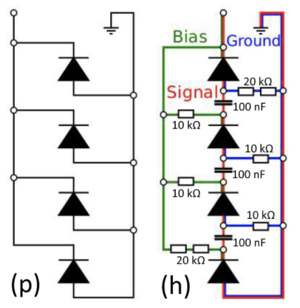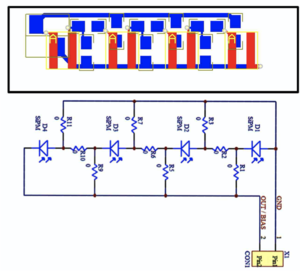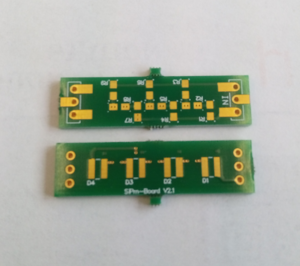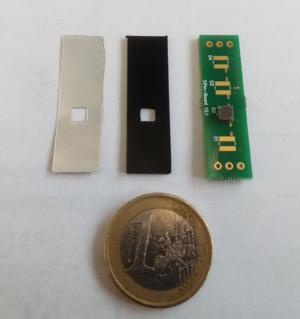Difference between revisions of "Sipm Board"
(Created page with "The SiPM board is a printed circuit board (PCB) designed to dock and process the signal from the SiPM-scintillator coupling into a readout. Ideally no information such as timi...") |
|||
| Line 1: | Line 1: | ||
| − | + | Die SiPM-Platine ist eine Leiterplatte (PCB), die dazu dient, das Signal der SiPM-Szintillator-Kopplung anzudocken und in eine Auslesung zu verarbeiten. Idealerweise sollten keine Informationen wie z. B. das Timing vom Szintillator verloren gehen, und das Signal könnte mit der Platine verstärkt/verarbeitet werden. Bei einigen Anwendungen, bei denen erhebliche Temperaturschwankungen auftreten, könnte auch ein Kompensator in die Platine eingebaut werden. Für das Muonpi-Projekt sollte das Board lediglich in der Lage sein, die SiPM-Szintillator-Kopplung an die Auslesung anzudocken. | |
| + | Die Schaltungskonfiguration der Platine hängt von der Anzahl der SiPMs ab, die sie aufnehmen soll. Für die Unterbringung eines einzelnen SiPMs ist die Konfiguration so, dass es nur mit Masse und Auslesung/Bias verbunden wird. Für den Anschluss mehrerer SiPMs gibt es jedoch zwei mögliche Konfigurationen: Parallel- (p) und Hybrid- (h) Konfiguration, wie unten dargestellt. | ||
| + | [[File:Jepretan Layar 2020-06-23 pukul 4.23.54 PM.png|thumb|Parallel (p) and hybrid (h) configuration of SiPM board <ref>[S. Zimmermann. The panda barrel-tof detector. DPG-Frühjahrstagung, Münster. Austrian Academy of Sciences, Stefan Meyer Insitute for Subatomic Physics, 28th of March, 2017.]</ref>. Der Signalpfad ist in rot, der Bias-Strom in grün und die Masse in blau abgebildet.]] | ||
| − | |||
| − | + | Beide Konfigurationen sind in Bezug auf die Leistung recht ähnlich, wobei die Hybridkonfiguration eine etwas schnellere steigende Flanke aufweist (um einige ns <ref>[Nies, L., Zaunick, H. G., & Brinkmann, K-. T.. Development of a SiPM-based readout-module for the characterization of various scintillator materials. arXiv. (2018). </ref>). Die Signalamplitude für die Hybridkonfiguration verringert sich um den Faktor <math>\frac{1}{\sqrt{N}}</math> wobei N die Anzahl der SiPMs ist, während sich die Signalamplitude bei paralleler Konfiguration nicht ändert. Allerdings sinkt auch das Timing der parallelen Konfiguration mit der Anzahl der angeschlossenen SiPMs; daher könnte für Anwendungen, die sehr zeitempfindlich sind, die Hybridkonfiguration erforderlich sein. Außerdem ist die Hybridkonfiguration komplexer, was die Herstellung der Konfiguration teurer machen könnte. Der Einfachheit halber verwendet das Muonpi-Projekt daher die parallele Konfiguration. Dadurch bleibt die Einfachheit erhalten, während die Option besteht, SiPM später hinzuzufügen. Der Schaltplan der SiPM-Platine für das Muon Pi-Projekt ist unten abgebildet. | |
| − | + | [[File:SiPMBoard.png| thumb| Schaltplan der im Muonpi-Projekt verwendeten SiPM-Karte<ref>[L. Nies, “Development of a sipm-based readout-module for the characterization of various scintillation materials (bachelor’s thesis),” (August 2017).]</ref>]] | |
| − | + | [[File:Sipm pcb unmounted.png|left|thumb|Foto der unbestückten SiPM-Leiterplatte V2.1]] | |
| − | + | [[File:Sipm_pcb_parts.png|center|thumb|Foto einer montierten SiPM-Leiterplatte V2.1 mit einzelnem SiPM (Standardkonfiguration), Gummiabstandshalter und Reflexionsfolie]] | |
| − | |||
| − | |||
| − | [[File:Sipm pcb unmounted.png|left|thumb| | ||
| − | [[File:Sipm_pcb_parts.png|center|thumb| | ||
Latest revision as of 22:02, 5 January 2021
Die SiPM-Platine ist eine Leiterplatte (PCB), die dazu dient, das Signal der SiPM-Szintillator-Kopplung anzudocken und in eine Auslesung zu verarbeiten. Idealerweise sollten keine Informationen wie z. B. das Timing vom Szintillator verloren gehen, und das Signal könnte mit der Platine verstärkt/verarbeitet werden. Bei einigen Anwendungen, bei denen erhebliche Temperaturschwankungen auftreten, könnte auch ein Kompensator in die Platine eingebaut werden. Für das Muonpi-Projekt sollte das Board lediglich in der Lage sein, die SiPM-Szintillator-Kopplung an die Auslesung anzudocken.
Die Schaltungskonfiguration der Platine hängt von der Anzahl der SiPMs ab, die sie aufnehmen soll. Für die Unterbringung eines einzelnen SiPMs ist die Konfiguration so, dass es nur mit Masse und Auslesung/Bias verbunden wird. Für den Anschluss mehrerer SiPMs gibt es jedoch zwei mögliche Konfigurationen: Parallel- (p) und Hybrid- (h) Konfiguration, wie unten dargestellt.

Beide Konfigurationen sind in Bezug auf die Leistung recht ähnlich, wobei die Hybridkonfiguration eine etwas schnellere steigende Flanke aufweist (um einige ns [2]). Die Signalamplitude für die Hybridkonfiguration verringert sich um den Faktor wobei N die Anzahl der SiPMs ist, während sich die Signalamplitude bei paralleler Konfiguration nicht ändert. Allerdings sinkt auch das Timing der parallelen Konfiguration mit der Anzahl der angeschlossenen SiPMs; daher könnte für Anwendungen, die sehr zeitempfindlich sind, die Hybridkonfiguration erforderlich sein. Außerdem ist die Hybridkonfiguration komplexer, was die Herstellung der Konfiguration teurer machen könnte. Der Einfachheit halber verwendet das Muonpi-Projekt daher die parallele Konfiguration. Dadurch bleibt die Einfachheit erhalten, während die Option besteht, SiPM später hinzuzufügen. Der Schaltplan der SiPM-Platine für das Muon Pi-Projekt ist unten abgebildet.

- ↑ [S. Zimmermann. The panda barrel-tof detector. DPG-Frühjahrstagung, Münster. Austrian Academy of Sciences, Stefan Meyer Insitute for Subatomic Physics, 28th of March, 2017.]
- ↑ [Nies, L., Zaunick, H. G., & Brinkmann, K-. T.. Development of a SiPM-based readout-module for the characterization of various scintillator materials. arXiv. (2018).
- ↑ [L. Nies, “Development of a sipm-based readout-module for the characterization of various scintillation materials (bachelor’s thesis),” (August 2017).]


